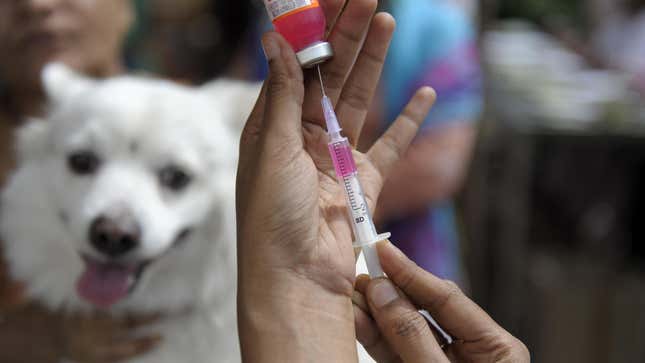
An Illinois man had the unfortunate distinction of becoming the first case of human rabies seen in the state in almost 70 years, health officials reported this week. Unfortunately, like most sick victims of rabies, the man did not survive. He had turned down preventive treatment a month earlier.
Rabies is caused by a virus (Rabies lyssavirus) that can infect most every mammal, including humans. Once inside a host, the virus makes its way to the nervous system, causing inflammation and neurological symptoms like confusion, aggression, excessive saliva production, a fear of water, and eventually paralysis and death. Typically, the virus spreads through bites or other exposure to a rabid animal’s saliva or mucus, which is loaded with the virus.
There is no effective treatment for rabies once symptoms begin, and only a handful of people are known to have survived the final stage of infection. But there is a widely available vaccine that can work even after a confirmed exposure to the virus, so long as it’s taken in the weeks before symptoms start. Exposed people are also given a large dose of antibodies against rabies collected from the blood of immunized people or animals.
Rabies remains a serious threat in many poorer parts of the world. But animal control programs and the mass vaccination of pets like dogs and cats have significantly driven down human cases in the U.S. and other countries. Nowadays, about one to two rabies deaths are reported in the U.S. annually, according to the Centers for Disease Control and Prevention. The virus still readily spreads among wildlife, though, and it can occasionally jump over to humans here under the right conditions.
On Tuesday, the Illinois Department of Public Health reported one of these rare encounters. In mid-August, a Lake County resident in his 80s woke up with a bat at his neck. The bat was captured, and an entire colony was later discovered to be living in his home. Once the bat was known to have rabies, the man was advised to seek post-exposure treatment. But for whatever reason, he declined. A month later, he began developing symptoms including neck pain, headache, finger numbness, and difficulty speaking; soon after, he died. Those who may have come into close contact with the man’s bodily fluids were also assessed and chose to undergo preventive treatment, officials said. It’s the first human rabies case reported in Illinois since 1954.
“Sadly, this case underscores the importance of raising public awareness about the risk of rabies exposure in the United States,” said Lake County Health Department Executive Director Mark Pfister in a statement. “Rabies infections in people are rare in the United States; however, once symptoms begin, rabies is almost always fatal, making it vital that an exposed person receive appropriate treatment to prevent the onset of rabies as soon as possible.”
Bats are the most commonly reported source of exposure to rabies in the U.S., accounting for 70% of human rabies deaths, the CDC says. And they may have been the original hosts of the ancestor virus that gave rise to rabies and other related viruses. But many animals are capable of spreading rabies to humans, and most bats don’t carry rabies, nor can you tell if a bat has rabies just by looking at it.
That’s why it’s important for anyone who has gotten bitten or scratched by an animal to be aware of their potential risk of rabies, especially if the animal was wild or not known to have been vaccinated against rabies, in the case of free-roaming pets. Ideally, the bitey animal can be captured and tested for rabies, but if not, doctors may still recommend post-exposure prophylaxis, depending on the circumstances. Though rabies infections in the U.S. are rare, about 55,000 Americans do get post-exposure treatment annually, according to the CDC.